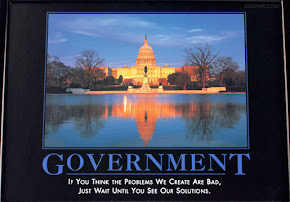Saturday, October 9, 2010
Overestimate fueled state's landmark diesel law
Mary Nichols, chairwoman of the board says she has no concern about her boards miscalculations. I'm sure the businesses that had to spend billions under the burden of the new regulations might have some concerns. After all, a 340 percent error is nothing to sneeze about.
This is just another example of a government board being given to environmental zealots (just my suspicion based on this article) and, as in the case of ClimateGate, facts being developed to support crippling legislation.
Excerpt: California grossly miscalculated pollution levels in a scientific analysis used to toughen the state's clean-air standards, and scientists have spent the past several months revising data and planning a significant weakening of the landmark regulation, The Chronicle has found.
The pollution estimate in question was too high - by 340 percent, according to the California Air Resources Board, the state agency charged with researching and adopting air quality standards. The estimate was a key part in the creation of a regulation adopted by the Air Resources Board in 2007, a rule that forces businesses to cut diesel emissions by replacing or making costly upgrades to heavy-duty, diesel-fueled off-road vehicles used in construction and other industries.
Mary Nichols, chairwoman of the California Air Resources Board, offered no explanation when The Chronicle questioned her about the diesel emissions miscalculation. She was recently asked why the air board estimate of a nitrous oxide source was off by at least a factor of two - air board scientists have since revised their numbers, and data show the estimate was off by 340 percent. Nichols' response: "I can't answer that for you."
Nichols was emphatic, though, when asked whether she has concerns about other scientific calculations made by air board scientists.
"No, no, no, no, no, no, no and no," she said.
Members of Nichols' board don't have an answer for the overestimate either, said Ron Roberts, an air board member who is a Republican supervisor in San Diego County and who voted in favor of the diesel regulation.
"One of the hardest things about being on the board is separating fact from political fancy," Roberts said.
"I think somehow some very poor decisions have been made and politics have entered the picture too much," he said. "There are plenty of excuses but no explanations."
The regulation - called the In-Use Off-Road Diesel Vehicle Regulation - was adopted by the board in July 2007 to cut the amount of emissions released by diesel vehicles, with some exceptions, that aren't operated on regular roads and highways. Most of the affected vehicles are used in construction, mining and airport ground support and include such machinery as bulldozers, dump trucks, forklifts and cranes.
The construction industry had said the rule would cost construction businesses $10 billion to $12 billion in equipment purchases or upgrades required to make the machines run cleaner.
Roberts and other board members were not told by Nichols that the scientist, Hien Tran, lied about earning a doctorate from UC Davis before they voted in favor of regulations based in part on his science. That vote took place in December 2008.
Nichols, who acknowledges she knew about the falsification prior to the vote, has apologized for not sharing that information with her fellow board members.
The Air Resources Board acknowledges that the new estimates mean that emitters of the pollution would need to make significantly smaller - and in turn less expensive - changes to their vehicles.
Overestimate fueled state's landmark diesel law
This is just another example of a government board being given to environmental zealots (just my suspicion based on this article) and, as in the case of ClimateGate, facts being developed to support crippling legislation.
Excerpt: California grossly miscalculated pollution levels in a scientific analysis used to toughen the state's clean-air standards, and scientists have spent the past several months revising data and planning a significant weakening of the landmark regulation, The Chronicle has found.
The pollution estimate in question was too high - by 340 percent, according to the California Air Resources Board, the state agency charged with researching and adopting air quality standards. The estimate was a key part in the creation of a regulation adopted by the Air Resources Board in 2007, a rule that forces businesses to cut diesel emissions by replacing or making costly upgrades to heavy-duty, diesel-fueled off-road vehicles used in construction and other industries.
Mary Nichols, chairwoman of the California Air Resources Board, offered no explanation when The Chronicle questioned her about the diesel emissions miscalculation. She was recently asked why the air board estimate of a nitrous oxide source was off by at least a factor of two - air board scientists have since revised their numbers, and data show the estimate was off by 340 percent. Nichols' response: "I can't answer that for you."
Nichols was emphatic, though, when asked whether she has concerns about other scientific calculations made by air board scientists.
"No, no, no, no, no, no, no and no," she said.
Members of Nichols' board don't have an answer for the overestimate either, said Ron Roberts, an air board member who is a Republican supervisor in San Diego County and who voted in favor of the diesel regulation.
"One of the hardest things about being on the board is separating fact from political fancy," Roberts said.
"I think somehow some very poor decisions have been made and politics have entered the picture too much," he said. "There are plenty of excuses but no explanations."
The regulation - called the In-Use Off-Road Diesel Vehicle Regulation - was adopted by the board in July 2007 to cut the amount of emissions released by diesel vehicles, with some exceptions, that aren't operated on regular roads and highways. Most of the affected vehicles are used in construction, mining and airport ground support and include such machinery as bulldozers, dump trucks, forklifts and cranes.
The construction industry had said the rule would cost construction businesses $10 billion to $12 billion in equipment purchases or upgrades required to make the machines run cleaner.
Roberts and other board members were not told by Nichols that the scientist, Hien Tran, lied about earning a doctorate from UC Davis before they voted in favor of regulations based in part on his science. That vote took place in December 2008.
Nichols, who acknowledges she knew about the falsification prior to the vote, has apologized for not sharing that information with her fellow board members.
The Air Resources Board acknowledges that the new estimates mean that emitters of the pollution would need to make significantly smaller - and in turn less expensive - changes to their vehicles.
Overestimate fueled state's landmark diesel law
Labels:
Big Government,
environment
Subscribe to:
Post Comments (Atom)






























No comments:
Post a Comment